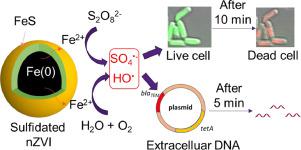Water Research ( IF 12.8 ) Pub Date : 2021-04-10 , DOI: 10.1016/j.watres.2021.117141 Zhigang Yu 1 , Hesamoddin Rabiee 1 , Jianhua Guo 1

|
Antimicrobial resistance continues to be a rising global threat to public health. It is well recognized that wastewater treatment plants are reservoirs of antibiotic resistant bacteria (ARB) and antibiotic resistance genes (ARGs). However, traditional disinfection techniques are not effective to simultaneously remove ARB and ARGs, and the dynamic analysis of ARB inactivation have also been deficient. In this study, sulfidated nano zerovalent iron (S-nZVI) coupled with persulfate (PS) was applied to simultaneously remove both ARB (E. coli K-12 with RP4 plasmid) and ARGs (extra- and intracellular ARGs). S-nZVI/PS completely inactivated ARB (~7.8-log reduction) within 10 min and degraded all extracellular ARGs (~8.0-log reduction) within 5 min. These efficiencies were significantly higher (decay rate constant, k = 0.138 min−1) than those achieved individually (S-nZVI: k = 0.076 min−1; PS: k = 0.008 min−1), implying a synergistic effect between S-nZVI and PS against ARB and ARGs. The efficient removal rate of ARB was also supported by confocal microscopy and microfluidics at a single-cell level. The complete inactivation of ARB by S-nZVI/PS was also demonstrated in real drinking water and real wastewater effluent that contained natural organic matter and suspended solids. Regrowth assays showed that the treated ARB was not observed after 72 h or longer incubation, suggesting that ARB was permanently inactivated by radicals such as SO4•- and •OH. The destruction of bacterial cells compromised the removal efficiency of the intracellular ARGs, with only ~4.0-log reduction after 60 min treatment by S-nZVI/PS. Collectively, our results suggest the feasibility of S-nZVI coupled with PS for simultaneous ARB and ARGs removal in real water matrices.
中文翻译:

硫化纳米零价铁和过硫酸盐对灭活抗生素耐药菌和抗生素耐药基因的协同作用
抗菌素耐药性继续成为全球公共卫生面临的日益严重的威胁。众所周知,污水处理厂是抗生素抗性细菌 (ARB) 和抗生素抗性基因 (ARG) 的储存库。然而,传统的消毒技术不能有效地同时去除 ARB 和 ARGs,并且对 ARB 灭活的动态分析也存在不足。在这项研究中,硫化纳米零价铁 (S-nZVI) 与过硫酸盐 (PS) 结合用于同时去除 ARB(带有 RP4 质粒的大肠杆菌K-12)和 ARG(细胞外和细胞内 ARG)。S-nZVI/PS 在 10 分钟内完全灭活 ARB(约 7.8-log 减少)并在 5 分钟内降解所有细胞外 ARG(约 8.0-log 减少)。这些效率明显更高(衰减率常数,k = 0.138 min -1)比单独获得的(S-nZVI :k = 0.076 min -1;PS :k = 0.008 min -1),意味着 S-nZVI 和 PS 之间对 ARB 和 ARGs 有协同作用。单细胞水平的共聚焦显微镜和微流体也支持 ARB 的有效去除率。S-nZVI/PS 对 ARB 的完全灭活也在含有天然有机物和悬浮固体的真实饮用水和真实废水中得到证实。再生长试验表明,经过 72 小时或更长时间的孵育后,未观察到处理过的 ARB,这表明 ARB 被自由基(如 SO 4 )永久灭活•-和•OH。细菌细胞的破坏损害了细胞内 ARGs 的去除效率,在 S-nZVI/PS 处理 60 分钟后仅减少了约 4.0-log。总的来说,我们的结果表明 S-nZVI 与 PS 在实际水基质中同时去除 ARB 和 ARGs 的可行性。



























 京公网安备 11010802027423号
京公网安备 11010802027423号